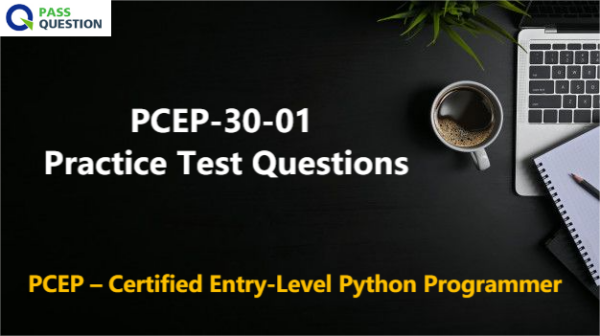PCEP-30-01 Practice Test Questions - Certified Entry-Level Python Programmer
Are you attempting the PCEP-30-01 PCEP – Certified Entry-Level Python Programmer exam? PassQuestion provides the latest PCEP-30-01 Practice Test Questions which guarantee your success in the final exam. These PCEP-30-01 Practice Test Questions cover all of the subjects of the PCEP exam to help you with understanding the PCEP-30-01 test easily. You will have to use our PCEP-30-01 Practice Test Questions multiple times so you can ensure your success in the real exam. It will provide you with a real exam scenario so you can get a better idea of how you can prepare for the PCEP exam. Make sure that you are using PCEP-30-01 Practice Test Questions that are created by the experts and will help you clear your exam on the first attempt.

PCEP – Certified Entry-Level Python Programmer
PCEP – Certified Entry-Level Python Programmer certification shows that the individual is familiar with universal computer programming concepts like data types, containers, functions, conditions, loops, as well as Python programming language syntax, semantics, and the runtime environment.
PCEP – Certified Entry-Level Python Programmer certification (Exam PCEP-30-0x) is a professional credential that measures the candidate's ability to accomplish coding tasks related to the essentials of programming in the Python language. A test candidate should demonstrate sufficient knowledge of the universal concepts of computer programming, the syntax and semantics of the Python language, as well as the skills in resolving typical implementation challenges with the help of the Python Standard Library.
PCEP-30-01 Exam will be retiring on December 31, 2022, and the new exam PCEP-30-02 is currently active.
Exam Information
Exam Name: PCEP Certified Entry-Level Python Programmer
Exam Code: PCEP-30-01
Exam Level: Entry
Pre-requisites: None
Duration: 45 minutes (exam) + approx. 5 minutes (Non-Disclosure Agreement/Tutorial)
Number of Questions: 30
Format: Single-choice and multiple-choice questions, drag & drop, gap fill | Python 3. x
Passing score: 70%
Language: English
Exam Topics
Basic Concepts (17%)
Data Types, Evaluations, and Basic I/O Operations (20%)
Control Flow – loops and conditional blocks (20%)
Data Collections – Lists, Tuples, and Dictionaries (23%)
Functions (20%)
View Online PCEP – Certified Entry-Level Python Programmer PCEP-30-01 Sample Questions
1. What is C Python?
A. It' a programming language that is a superset of the C language,
B. designed to produce Python-like performance with code written in C
C. It' a programming language that is a superset of the Python,
D. designed to produce C-like performance with code written in Python
E. It's a default, reference implementation of the C language, written in Python
F. It's a default, reference implementation of the Python language, written in C
Answer: F
2. What is the best definition of a script?
A. It's an error message generated by the interpreter
B. It's a text file that contains instructions which make up a Python program
C. It's an error message generated by the compiler
D. It's a text file that contains sequences of zeroes and ones
Answer: B
3. What do you call a file containing a program written in a high-level programming language?
A. A target file
B. A code file
C. A source file
D. A machine file
Answer: C
4. How did Python, the programming language, get its name?
A. Guido van Roddum named it to honor Python of Catana, a dramatic poet of the time of Alexander the Grerat
B. Guido van Roddum named it after the Pythonidae - a family of large, nonvenomous snakes
C. Guido van Roddum named it to honor Monty Python's Flying Circus, a BBC comedy series popular
in the 1970s
Answer: C
5. Strings in Python are delimited with:
A. backslashes (i.e., \)
B. double quotes (i.e., ") or single quotes (i.e., ')
C. asterisks (i.e., *)
D. dollar symbol (i.e., $)
Answer: B
6. What are the four fundamental elements that make a language?
A. An alphabet, phonetics, phonology, and semantics
B. An alphabet, a lexis, phonetics, and semantics
C. An alphabet, morphology, phonetics, and semantics
D. An alphabet, a lexis, a syntax, and semantics
Answer: D
- TOP 50 Exam Questions
-
Exam
All copyrights reserved 2025 PassQuestion NETWORK CO.,LIMITED. All Rights Reserved.

